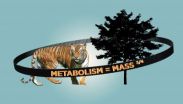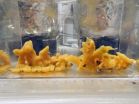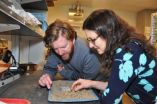(Press-News.org) VIDEO:
Enabled by the birefringence of liquid crystal, motion of 24nm thick bacteria flagella now is easily visible using a simple polarizing microscope.
Click here for more information.
WASHINGTON D.C. Feb. 17, 2014 -- Plop living, swimming bacteria into a novel water-based, nontoxic liquid crystal and a new physics takes over. The dynamic interaction of the bacteria with the liquid crystal creates a novel form of soft matter: living liquid crystal.
The new type of active material, which holds promise for improving the early detection of diseases, was developed by a research collaboration based at Ohio's Kent State University and Illinois' Argonne National Laboratory. The team will present their work at the 58th annual Biophysical Society Meeting, held in San Francisco, Feb.15-19.
As a biomechanical hybrid, living liquid crystal moves and reshapes itself in response to external stimuli. It also stores energy just as living organisms do to drive its internal motion. And it possesses highly desirable optical properties. In a living liquid crystal system, with the aid of a simple polarizing microscope, you can see with unusual clarity the wake-like trail stimulated by the rotation of bacterial flagella just 24-nanometers thick, about 1/4000th the thickness of an average human hair.
You can also control and guide active movements of the bacteria by manipulating variables such as oxygen availability, temperature or surface alignment, thus introducing a new design concept for creating microfluidic biological sensors. Living liquid crystal provides a medium to amplify tiny reactions that occur at the micro- and nano-scales – where molecules and viruses interact – and to also easily optically detect and analyze these reactions. That suits living liquid crystal to making sensing devices that monitor biological processes such as cancer growth, or infection. Such microfluidic technology is of increasing importance to biomedical sensing as a means of detecting disease in its earliest stages when it is most treatable, and most cost-effectively managed.
VIDEO:
Even at low Reynolds number, active bacteria can create periodic patterns when swimming in the viscoelastic liquid crystal.
Click here for more information.
"As far as we know, these things have never been done systematically as we did before in experimental physics," explained Shuang Zhou, a Ph.D. candidate at Ohio's Kent State University. He collaborated on the project with Oleg Lavrentovich of Kent State, Andrey Sokolov of Argonne National Laboratory, in Illinois, and Igor Aranson of Argonne National Laboratory and Northwestern University, in Evanston, Ill.
"There are many potential applications for this kind of new material, but some of the more immediate are new approaches to biomedical sensing design," Zhou said. He likens the current investigation to the "first handful of gold scooped out of a just-opened treasure chest. There are many more things to be done."
INFORMATION:
The presentation "Living Liquid Crystals" by Shuang Zhou, Andrey Sokolov, Oleg D. Lavrentovich and Igor S. Aranson will be at 1:45 p.m. on Monday, February 17, 2014 in Hall D in San Francisco's Moscone Convention Center.
ABSTRACT: http://tinyurl.com/pmvbfbp
ABOUT THE MEETING
Each year, the Biophysical Society Annual Meeting brings together more than 7,000 researchers working in the multidisciplinary fields representing biophysics. With more than 4,200 poster presentations, over 200 exhibits, and more than 20 symposia, the BPS Annual Meeting is the largest meeting of biophysicists in the world. Despite its size, the meeting retains its small-meeting flavor through its subgroup symposia, platform sessions, social activities, and committee programs.
The 58th Annual Meeting will be held at the Moscone Convention Center, 747 Howard Street, San Francisco, California.
PRESS REGISTRATION
The Biophysical Society invites professional journalists, freelance science writers and public information officers to attend its Annual Meeting free of charge. For press registration, contact Alisha Yocum at ayocum@biophysics.org or Jason Bardi at 240-535-4954.
QUICK LINKS
Main Meeting Page: http://tinyurl.com/mfjh37p
Program Highlights: http://tinyurl.com/mosxrof
Abstracts Search: http://tinyurl.com/lbrearu
ABOUT THE SOCIETY
The Biophysical Society, founded in 1958, is a professional, scientific Society established to encourage development and dissemination of knowledge in biophysics. The Society promotes growth in this expanding field through its annual meeting, monthly journal, and committee and outreach activities. Its 9000 members are located throughout the U.S. and the world, where they teach and conduct research in colleges, universities, laboratories, government agencies, and industry. For more information on the Society, or the 2014 Annual Meeting, visit http://www.biophysics.org
It's alive! Bacteria-filled liquid crystals could improve biosensing
Researchers present the new form of matter at the 58th Biophysical Society Meeting in San Francisco
2014-02-18
ELSE PRESS RELEASES FROM THIS DATE:
Finding ways to detect and treat Alzheimer's disease
2014-02-18
WASHINGTON D.C. Feb. 17, 2014 -- Alzheimer's disease has long been marked by progress -- but not the kind of progress the medical community seeks. It is the most common form of dementia among older Americans, and its risk increases with increasing age; for those living with the disease, its ravages get worse over time; and as we move into the 21st century, it will place a greater and greater burden on society. The number of Americans living with Alzheimer's has doubled since 1980 and is expected to triple again by 2050.
Sadly, Alzheimer's disease has been the least prone ...
Annals of Internal Medicine tip sheet for Feb. 18, 2014
2014-02-18
1. Aortic valve replacement improves function but may not improve quality of life
Transcatheter aortic valve replacement (TAVR) improves functional status but may not improve overall quality of life, according to an article being published in Annals of Internal Medicine. Aortic stenosis (AS) is the most common valvular heart disease in developing countries and it affects up to 3 percent of adults older than 75. In recent years, TAVR has emerged as an alternative treatment to surgical aortic valve replacement (SAVR) for high-risk or inoperable patients with symptomatic ...
Stress hormones in traders may trigger 'risk aversion' and contribute to market crises
2014-02-18
High levels of the stress hormone cortisol may contribute to the risk aversion and 'irrational pessimism' found among bankers and fund managers during financial crises, according to a new study.
The study's authors say that risk takers in the financial world exhibit risk averse behaviour during periods of extreme market volatility – just when a crashing market most needs them to take risks – and that this change in their appetite for risk may be "physiologically-driven", specifically by the body's response to cortisol. They suggest that stress could be an "under-appreciated" ...
How well do football helmets protect players from concussions?
2014-02-18
PHILADELPHIA – A new study finds that football helmets currently used on the field may do little to protect against hits to the side of the head, or rotational force, an often dangerous source of brain injury and encephalopathy. The study released today will be presented at the American Academy of Neurology's 66th Annual Meeting in Philadelphia, April 26 to May 3, 2014.
"Protection against concussion and complications of brain injury is especially important for young players, including elementary and middle school, high school and college athletes, whose still-developing ...
How evolution shapes the geometries of life
2014-02-18
Why does a mouse's heart beat about the same number of times in its lifetime as an elephant's, although the mouse lives about a year, while an elephant sees 70 winters come and go? Why do small plants and animals mature faster than large ones? Why has nature chosen such radically different forms as the loose-limbed beauty of a flowering tree and the fearful symmetry of a tiger?
These questions have puzzled life scientists since ancient times. Now an interdisciplinary team of researchers from the University of Maryland and the University of Padua in Italy propose a thought-provoking ...
Theory on origin of animals challenged: Animals needs only extremely little oxygen
2014-02-18
One of science's strongest dogmas is that complex life on Earth could only evolve when oxygen levels in the atmosphere rose to close to modern levels. But now studies of a small sea sponge fished out of a Danish fjord shows that complex life does not need high levels of oxygen in order to live and grow.
The origin of complex life is one of science's greatest mysteries. How could the first small primitive cells evolve into the diversity of advanced life forms that exists on Earth today? The explanation in all textbooks is: Oxygen. Complex life evolved because the atmospheric ...
Researchers warn against abrupt stop to geoengineering method
2014-02-18
As a range of climate change mitigation scenarios are discussed, University of Washington researchers have found that the injection of sulfate particles into the atmosphere to reflect sunlight and curb the effects of global warming could pose a severe threat if not maintained indefinitely and supported by strict reductions in greenhouse gas (GHG) emissions.
The new study, published today, 18 February, in IOP Publishing's journal Environmental Research Letters, has highlighted the risks of large and spatially expansive temperature increases if solar radiation management ...
First biological marker for major depression could enable better diagnosis and treatment
2014-02-18
Teenage boys who show a combination of depressive symptoms and elevated levels of the 'stress hormone' cortisol are up to fourteen times more likely to develop major depression than those who show neither trait, according to research funded by the Wellcome Trust.
In a study published today in the Proceedings of the National Academy of Sciences, researchers from the University of Cambridge have identified the first biomarker – a biological signpost – for major, or clinical, depression. They argue that this could help identify those boys in particular at greatest risk ...
Why tackling appetite could hold the key to preventing childhood obesity
2014-02-18
A heartier appetite is linked to more rapid infant growth and to genetic predisposition to obesity, according to two papers published in JAMA Pediatrics today (Monday).
The studies investigated how weight gain is linked to two key aspects of appetite, namely lower satiety responsiveness (a reduced urge to eat in response to internal 'fullness' signals) and higher food responsiveness (an increased urge to eat in response to the sight or smell of nice food).
The first paper reveals that infants with a heartier appetite grew more rapidly up to age 15 months, potentially ...
Ancient herring catch nets fisheries weakness
2014-02-18
Archaeological data indicate modern herring management needs to take a longer look into the past to manage fisheries for the future says a new study involving Simon Fraser University researchers.
That is one of the key findings in the study, just published online in Proceedings of the National Academy of Sciences (PNAS). SFU researchers Iain McKechnie, Dana Lepofsky and Ken Lertzman, and scientists in Ontario, Alberta and the United States are its co-authors.
The study is one of many initiatives of the SFU-based Herring School, a group of researchers that investigates ...
LAST 30 PRESS RELEASES:
University of Oklahoma researcher awarded funding to pursue AI-powered material design
Exploring how the visual system recovers following injury
Support for parents with infants at pediatric check-ups leads to better reading and math skills in elementary school
Kids’ behavioral health is a growing share of family health costs
Day & night: Cancer disrupts the brain’s natural rhythm
COVID-19 vaccination significantly reduces risk to pregnant women and baby
The role of vaccination in maternal and perinatal outcomes associated with COVID-19 in pregnancy
Mayo Clinic smartwatch system helps parents shorten and defuse children's severe tantrums early
Behavioral health spending spikes to 40% of all children’s health expenditures, nearly doubling in a decade
Digital cognitive behavioral treatment for generalized anxiety disorder
Expenditures for pediatric behavioral health care over time and estimated family financial burden
Air conditioning in nursing homes and mortality during extreme heat
The Alps to lose a record number of glaciers in the next decade
What makes a good proton conductor?
New science reporting guide published for journalists in Bulgaria
New international study reveals major survival gaps among children with cancer
New science reporting guide published for journalists in Turkey
Scientists develop a smarter mRNA therapy that knows which cells to target
Neuroanatomy-informed brain–machine hybrid intelligence for robust acoustic target detection
Eight SwRI hydrogen projects funded by ENERGYWERX
The Lundquist Institute and its start-up company Vitalex Biosciences Announces Strategic Advancement of Second-Generation fungal Vaccine VXV-01 through Phase 1 Trials under $40 Million Competitive Con
Fine particles in pollution are associated with early signs of autoimmune disease
Review article | Towards a Global Ground-Based Earth Observatory (GGBEO): Leveraging existing systems and networks
Penn and UMich create world’s smallest programmable, autonomous robots
Cleveland researchers launch first major study to address ‘hidden performance killer’ in athletes
To connect across politics, try saying what you oppose
Modulating key interaction prevents virus from entering cells
Project explores barriers to NHS career progression facing international medical graduates
Jeonbuk National University researchers explore the impact of different seasonings on the flavor perception of Doenjang soup
Two Keck Medicine of USC Hospitals named Leapfrog Top Teaching Hospitals
[Press-News.org] It's alive! Bacteria-filled liquid crystals could improve biosensingResearchers present the new form of matter at the 58th Biophysical Society Meeting in San Francisco





